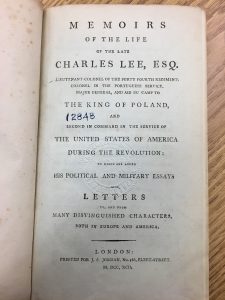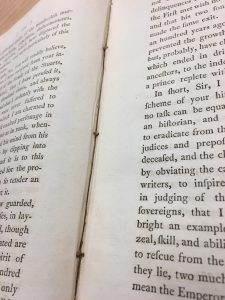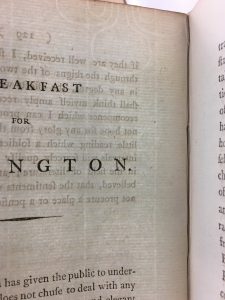My first concern with this assignment was whether or not I would be able to find a book with provenance to research. Luckily, all I needed was to send one… Read More
My first concern with this assignment was whether or not I would be able to find a book with provenance to research. Luckily, all I needed was to send one text to my dad, because then I was introduced to “Lietuviu Kalbos Gramatika,” a Lithuanian grammar book that had belonged to his father. Starting my research on previous owners was relatively easy because I was able to get information about how my grandfather had gotten the book and how he felt about going to the school where he had used it. My great-grandfather immigrated to the US from Lithuania in 1907, so I think that this played a role in the attempt to keep the Lithuanian language alive to some extent, and has kept the book in the family.
At the bottom right-hand corner of almost all of the pages of the book, I could see the letters “EZB” punched through the pages. On the edges of the book, I could also see “EB” written there, which makes me think that at some point there was another owner with these initials, but I wasn’t able to find any information about it.
I had forgotten that Lithuanian is a strange language, so finding information about where “Lietuviu Kalbos Gramatika” was printed was harder than I had anticipated it would be. Most of the sources I found on Marijampole, Lithuania and its printing house weren’t able to be translated into English. The introduction to the book, however, gave me a lot of information about the specific purpose of the book, which made it easier to see how the intent differed from how this little grammar book was actually used. Admittedly, there wasn’t much of a difference between the intended use and actual use of the book. The author, Rev. Dr. Jonas Starkus, was perhaps a bit more enthusiastic about students learning Lithuanian than the students themselves. I was also glad to see that the school had institutional stamps on the title page so I didn’t have to rely solely on family history to find Marianapolis Preparatory School, and background information about the school and its mission.
I’m not sure that I feel any differently about marginalia and annotation in books as a result of this assignment, but I do like the idea that books can have histories that are just as involved as the history of people themselves. I’ve always liked seeing notes from previous owners written in my books, but taking note of marginalia usually happens as a passing, “what were they thinking?” instead of thinking about where that book had been and what purpose it served. So I think that it isn’t that I feel or think differently about marginalia and annotation, I’m just thinking about them in a different context; the context of the book itself and not whether or not that note makes me laugh as I read. Now that I’ve glanced at the syllabus again (after writing the rest of this paragraph), I realize that this is, almost verbatim, the goal of this class, so I would call this assignment a success!
Sources Used:
http://www.lituanus.org/1992_3/92_3_01.htm
http://www.marianapolis.org/page.cfm?p=3521
https://lt.wikipedia.org/wiki/Marijampol%C4%97s_spaustuv%C4%97

 For this assignment I decided return to the book from the first assignment, “Memoirs of the Life of the Late Charles Lee, Esq.,” which was published in 1792.
For this assignment I decided return to the book from the first assignment, “Memoirs of the Life of the Late Charles Lee, Esq.,” which was published in 1792.
 When I started to look at the signatures, I began making notes of everything hoping that what I was looking at would eventually make sense. I also noticed that this book has catchwords. The preface, which was only two pages long, had the signatures b and b2, and the first page of text was marked with a B. The following pages had signatures up to B4, four pages without a signature, and then a page with C for the signature, and this pattern continued throughout the book. This told me that there were 8 leaves per gathering, which made me feel pretty good about having an octavo book in my hands.
When I started to look at the signatures, I began making notes of everything hoping that what I was looking at would eventually make sense. I also noticed that this book has catchwords. The preface, which was only two pages long, had the signatures b and b2, and the first page of text was marked with a B. The following pages had signatures up to B4, four pages without a signature, and then a page with C for the signature, and this pattern continued throughout the book. This told me that there were 8 leaves per gathering, which made me feel pretty good about having an octavo book in my hands.